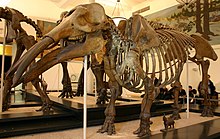Gomphotherium
| Gomphotherium Temporal range:
| |
|---|---|

| |
| Specimen of Gomphotherium productum at the AMNH | |
| Scientific classification | |
| Domain: | Eukaryota |
| Kingdom: | Animalia |
| Phylum: | Chordata |
| Class: | Mammalia |
| Order: | Proboscidea |
| Family: | †Gomphotheriidae |
| Genus: | †Gomphotherium Burmeister, 1837 |
| Species | |
|
Subgenus Gomphotherium
Subgenus Genomastodon
Incertae sedis
| |
| Synonyms | |
| |
Gomphotherium (/ˌɡɒmfəˈθɪəriəm/; "welded beast") is an extinct genus of proboscids from the Neogene and early Pleistocene of Eurasia, Africa, and North America.[2]
Description
G. productum is known from a 35-year-old male 2.51 m (8 ft 3 in) tall weighing 4.6 t (4.5 long tons; 5.1 short tons). Even larger is G. steinheimense, known from a complete 37-year-old male found in Mühldorf, Germany, which is 3.17 m (10.4 ft) tall and weighed 6.7 t (6.6 long tons; 7.4 short tons).[3] It had four tusks, two on the upper jaw and two on the elongated lower jaw. The lower tusks are parallel and shaped like a shovel and were probably used for digging up food from mud.[citation needed] Unlike modern elephants, the upper tusks were covered by a layer of enamel. Compared to elephants, the skull was more elongated and low, indicating that the animal had a short trunk, rather like a tapir's.[citation needed] These animals probably lived in swamps or near lakes, using their tusks to dig or scrape up aquatic vegetation. In comparison to earlier proboscids, Gomphotherium had far fewer molars; the remaining ones had high ridges to expand their grinding surfaces. Gomphotherium spp. inhabited dry wooded regions near lakes.[citation needed]
Taxonomy
The following cladogram shows the placement of the genus Gomphotherium among other proboscideans, based on hyoid characteristics:[4]
| ||||||||||||||||||||||||||||||||||
-
Gomphotherium angustidens
-
Gomphotherium productum
-
G. angustidens by Charles R. Knight
-
G. angustidens skeleton
-
Skeletal restoration of G. productum (right) and G. steinheimense (left)
References
- ^ Wang, Shi-Qi; Li, Yu; Duangkrayom, Jaroon; Yang, Xiang-Wen; He, Wen; Chen, Shan-Qin (2017). "A new species of Gomphotherium (Proboscidea, Mammalia) from China and the evolution of Gomphotherium in Eurasia". Journal of Vertebrate Paleontology. 37 (3): e1318284. doi:10.1080/02724634.2017.1318284.
- ^ Wang, Wei; Liao, Wei; Li, Dawei; Tian, Feng (1 July 2014). "Early Pleistocene large-mammal fauna associated with Gigantopithecus at Mohui Cave, Bubing Basin, South China". Quaternary International. 354: 122–130. Bibcode:2014QuInt.354..122W. doi:10.1016/j.quaint.2014.06.036. ISSN 1040-6182.
- ^ Larramendi, A. (2016). "Shoulder height, body mass and shape of proboscideans" (PDF). Acta Palaeontologica Polonica. 61. doi:10.4202/app.00136.2014.
- ^ Shoshani, J.; Tassy, P. (2005). "Advances in proboscidean taxonomy & classification, anatomy & physiology, and ecology & behavior". Quaternary International. 126–128: 5–20. Bibcode:2005QuInt.126....5S. doi:10.1016/j.quaint.2004.04.011.







